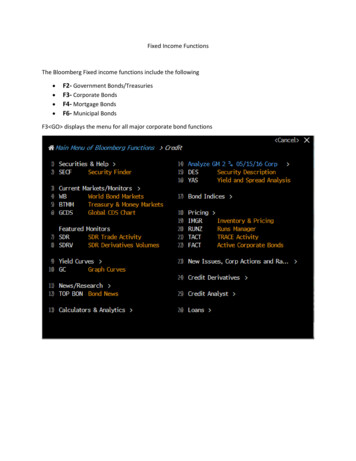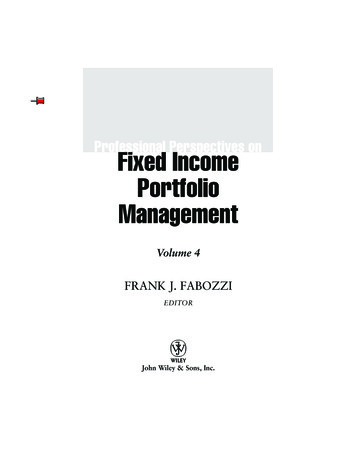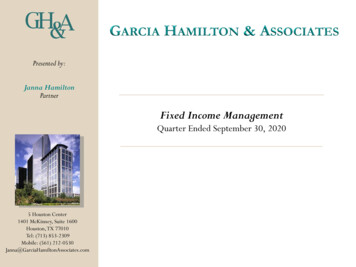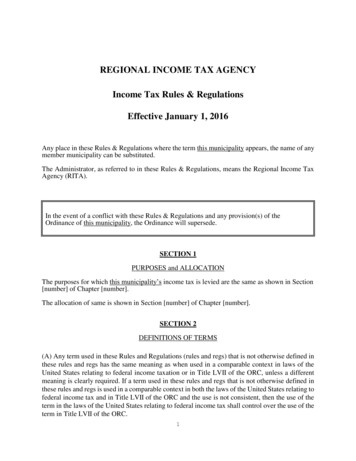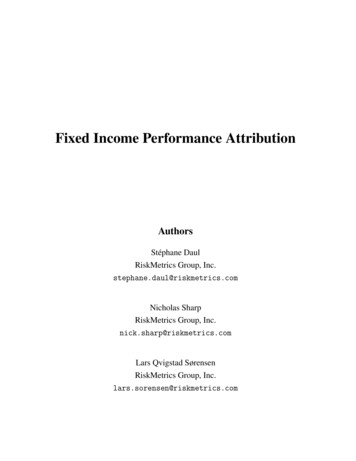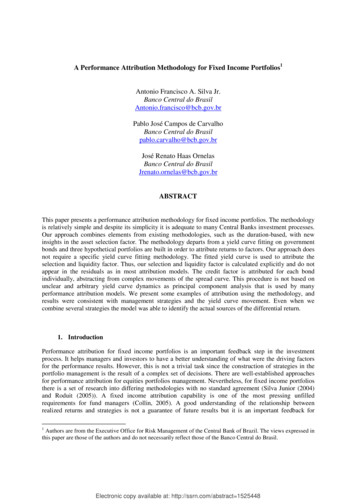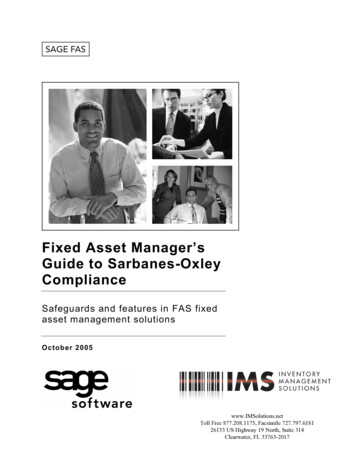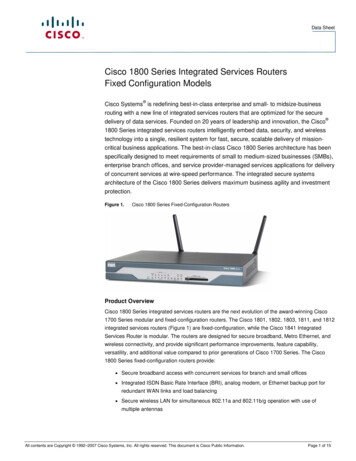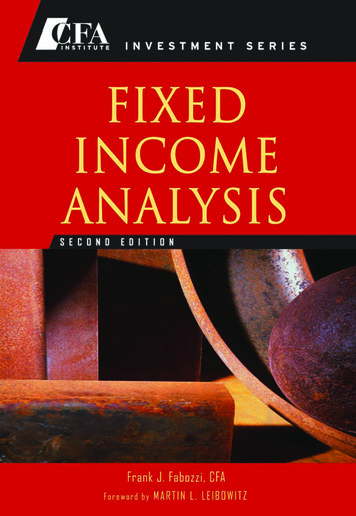
Transcription
FIXED INCOMEANALYSISSecond EditionFrank J. Fabozzi, PhD, CFA, CPAwith contributions fromMark J.P. Anson, PhD, CFA, CPA, Esq.Kenneth B. Dunn, PhDJ. Hank Lynch, CFAJack Malvey, CFAMark Pitts, PhDShrikant RamamurthyRoberto M. SellaChristopher B. Steward, CFAJohn Wiley & Sons, Inc.
FIXED INCOMEANALYSIS
CFA Institute is the premier association for investment professionals around the world,with over 85,000 members in 129 countries. Since 1963 the organization has developedand administered the renowned Chartered Financial Analyst Program. With a rich historyof leading the investment profession, CFA Institute has set the highest standards in ethics,education, and professional excellence within the global investment community, and is theforemost authority on investment profession conduct and practice.Each book in the CFA Institute Investment Series is geared toward industry practitionersalong with graduate-level finance students and covers the most important topics in theindustry. The authors of these cutting-edge books are themselves industry professionals andacademics and bring their wealth of knowledge and expertise to this series.
FIXED INCOMEANALYSISSecond EditionFrank J. Fabozzi, PhD, CFA, CPAwith contributions fromMark J.P. Anson, PhD, CFA, CPA, Esq.Kenneth B. Dunn, PhDJ. Hank Lynch, CFAJack Malvey, CFAMark Pitts, PhDShrikant RamamurthyRoberto M. SellaChristopher B. Steward, CFAJohn Wiley & Sons, Inc.
c 2004, 2007 by CFA Institute. All rights reserved.Copyright Published by John Wiley & Sons, Inc., Hoboken, New Jersey.Published simultaneously in Canada.No part of this publication may be reproduced, stored in a retrieval system, or transmitted in any form or by anymeans, electronic, mechanical, photocopying, recording, scanning, or otherwise, except as permitted under Section107 or 108 of the 1976 United States Copyright Act, without either the prior written permission of the Publisher, orauthorization through payment of the appropriate per-copy fee to the Copyright Clearance Center, Inc., 222Rosewood Drive, Danvers, MA 01923, (978) 750-8400, fax (978) 646-8600, or on the Web at www.copyright.com.Requests to the Publisher for permission should be addressed to the Permissions Department, John Wiley & Sons,Inc., 111 River Street, Hoboken, NJ 07030, (201) 748-6011, fax (201) 748-6008, or online athttp://www.wiley.com/go/permissions.Limit of Liability/Disclaimer of Warranty: While the publisher and author have used their best efforts in preparingthis book, they make no representations or warranties with respect to the accuracy or completeness of the contents ofthis book and specifically disclaim any implied warranties of merchantability or fitness for a particular purpose. Nowarranty may be created or extended by sales representatives or written sales materials. The advice and strategiescontained herein may not be suitable for your situation. You should consult with a professional where appropriate.Neither the publisher nor author shall be liable for any loss of profit or any other commercial damages, including butnot limited to special, incidental, consequential, or other damages.For general information on our other products and services or for technical support, please contact our CustomerCare Department within the United States at (800) 762-2974, outside the United States at (317) 572-3993 or fax(317) 572-4002.Wiley also publishes its books in a variety of electronic formats. Some content that appears in print may not beavailable in electronic formats. For more information about Wiley products, visit our Web site at www.wiley.com.Library of Congress Cataloging-in-Publication Data:Fabozzi, Frank J.Fixed income analysis / Frank J. Fabozzi.—2nd ed.p. cm.—(CFA Institute investment series)Originally published as: Fixed income analysis for the chartered financialanalyst program. New Hope, Pa. : F. J. Fabozzi Associates, c2000.Includes index.ISBN-13: 978-0-470-05221-1 (cloth)ISBN-10: 0-470-05221-X (cloth)1. Fixed-income securities. I. Fabozzi, Frank J. Fixed income analysis forthe chartered financial analyst program. 2006. II. Title.HG4650.F329 2006332.63’23—dc222006052818Printed in the United States of America.10 9 8 7 6 5 4 3 2 1
nNote on Rounding DifferencesCHAPTER 1Features of Debt SecuritiesI.IntroductionII. Indenture and CovenantsIII. MaturityIV. Par ValueV. Coupon RateVI. Provisions for Paying Off BondsVII. Conversion PrivilegeVIII. Put ProvisionIX. Currency DenominationX. Embedded OptionsXI. Borrowing Funds to Purchase BondsCHAPTER 2Risks Associated with Investing in BondsI.IntroductionII. Interest Rate RiskIII. Yield Curve RiskIV. Call and Prepayment RiskV. Reinvestment RiskVI. Credit RiskVII. Liquidity RiskVIII. Exchange Rate or Currency RiskIX. Inflation or Purchasing Power RiskX. Volatility 4v
viContentsXI. Event RiskXII. Sovereign Risk3536CHAPTER 3Overview of Bond Sectors and Instruments37I.IntroductionII. Sectors of the Bond MarketIII. Sovereign BondsIV. Semi-Government/Agency BondsV. State and Local GovernmentsVI. Corporate Debt SecuritiesVII. Asset-Backed SecuritiesVIII. Collateralized Debt ObligationsIX. Primary Market and Secondary Market for Bonds373739445356676970CHAPTER 4Understanding Yield SpreadsI.II.III.IV.V.VI.IntroductionInterest Rate DeterminationU.S. Treasury RatesYields on Non-Treasury SecuritiesNon-U.S. Interest RatesSwap SpreadsCHAPTER 5Introduction to the Valuation of Debt SecuritiesI.II.III.IV.V.IntroductionGeneral Principles of ValuationTraditional Approach to ValuationThe Arbitrage-Free Valuation ApproachValuation ModelsCHAPTER 6Yield Measures, Spot Rates, and Forward RatesI.II.III.IV.V.IntroductionSources of ReturnTraditional Yield MeasuresTheoretical Spot RatesForward RatesCHAPTER 7Introduction to the Measurement of Interest Rate RiskI.II.IntroductionThe Full Valuation 35147157157157
viiContentsIII.IV.V.VI.VII.Price Volatility Characteristics of BondsDurationConvexity AdjustmentPrice Value of a Basis PointThe Importance of Yield VolatilityCHAPTER 8Term Structure and Volatility of Interest RatesI.IntroductionII. Historical Look at the Treasury Yield CurveIII. Treasury Returns Resulting from Yield Curve MovementsIV. Constructing the Theoretical Spot Rate Curve for TreasuriesV. The Swap Curve (LIBOR Curve)VI. Expectations Theories of the Term Structure of Interest RatesVII. Measuring Yield Curve RiskVIII. Yield Volatility and MeasurementCHAPTER 9Valuing Bonds with Embedded OptionsI.IntroductionII. Elements of a Bond Valuation ModelIII. Overview of the Bond Valuation ProcessIV. Review of How to Value an Option-Free BondV. Valuing a Bond with an Embedded Option Using the Binomial ModelVI. Valuing and Analyzing a Callable BondVII. Valuing a Putable BondVIII. Valuing a Step-Up Callable NoteIX. Valuing a Capped FloaterX. Analysis of Convertible BondsCHAPTER 10Mortgage-Backed Sector of the Bond MarketI.II.III.IV.V.VI.VII.IntroductionResidential Mortgage LoansMortgage Passthrough SecuritiesCollateralized Mortgage ObligationsStripped Mortgage-Backed SecuritiesNonagency Residential Mortgage-Backed SecuritiesCommercial Mortgage-Backed SecuritiesCHAPTER 11Asset-Backed Sector of the Bond MarketI.II.IntroductionThe Securitization Process and Features of 98302302303
viiiContentsIII. Home Equity LoansIV. Manufactured Housing-Backed SecuritiesV. Residential MBS Outside the United StatesVI. Auto Loan-Backed SecuritiesVII. Student Loan-Backed SecuritiesVIII. SBA Loan-Backed SecuritiesIX. Credit Card Receivable-Backed SecuritiesX. Collateralized Debt ObligationsCHAPTER 12Valuing Mortgage-Backed and Asset-Backed 25327335IntroductionCash Flow Yield AnalysisZero-Volatility SpreadMonte Carlo Simulation Model and OASMeasuring Interest Rate RiskValuing Asset-Backed SecuritiesValuing Any Security335336337338351358359CHAPTER 13Interest Rate Derivative Instruments360I.II.III.IV.V.IntroductionInterest Rate FuturesInterest Rate OptionsInterest Rate SwapsInterest Rate Caps and FloorsCHAPTER 14Valuation of Interest Rate Derivative InstrumentsI.II.III.IV.V.IntroductionInterest Rate Futures ContractsInterest Rate SwapsOptionsCaps and FloorsCHAPTER 15General Principles of Credit AnalysisI.II.III.IV.V.IntroductionCredit RatingsTraditional Credit AnalysisCredit Scoring ModelsCredit Risk ModelsAppendix: Case 453455456
ixContentsCHAPTER 16Introduction to Bond Portfolio ManagementI.II.III.IV.V.IntroductionSetting Investment Objectives for Fixed-Income InvestorsDeveloping and Implementing a Portfolio StrategyMonitoring the PortfolioAdjusting the PortfolioCHAPTER 17Measuring a Portfolio’s Risk ProfileI.IntroductionII. Review of Standard Deviation and Downside Risk MeasuresIII. Tracking ErrorIV. Measuring a Portfolio’s Interest Rate RiskV. Measuring Yield Curve RiskVI. Spread RiskVII. Credit RiskVIII. Optionality Risk for Non-MBSIX. Risks of Investing in Mortgage-Backed SecuritiesX. Multi-Factor Risk ModelsCHAPTER 18Managing Funds against a Bond Market IndexI.II.III.IV.V.VI.VII.IntroductionDegrees of Active ManagementStrategiesScenario Analysis for Assessing Potential PerformanceUsing Multi-Factor Risk Models in Portfolio ConstructionPerformance EvaluationLeveraging StrategiesCHAPTER 19Portfolio Immunization and Cash Flow MatchingI.II.III.IV.V.IntroductionImmunization Strategy for a Single LiabilityContingent ImmunizationImmunization for Multiple LiabilitiesCash Flow Matching for Multiple LiabilitiesCHAPTER 20Relative-Value Methodologies for Global Credit BondPortfolio Management (by Jack Malvey)I.II.IntroductionCredit Relative-Value 7560560561
xContentsIII. Total Return AnalysisIV. Primary Market AnalysisV. Liquidity and Trading AnalysisVI. Secondary Trade RationalesVII. Spread AnalysisVIII. Structural AnalysisIX. Credit Curve AnalysisX. Credit AnalysisXI. Asset Allocation/Sector Rotation565566567568572575579579581CHAPTER 21International Bond Portfolio Management (by Christopher B.Steward, J. Hank Lynch, and Frank J. Fabozzi)I.II.III.IV.IntroductionInvestment Objectives and Policy StatementsDeveloping a Portfolio StrategyPortfolio ConstructionAppendix583583584588595614CHAPTER 22Controlling Interest Rate Risk with Derivatives (by Frank J. Fabozzi,Shrikant Ramamurthy, and Mark Pitts)I.II.III.IV.V.IntroductionControlling Interest Rate Risk with FuturesControlling Interest Rate Risk with SwapsHedging with OptionsUsing Caps and Floors617617617633637649CHAPTER 23Hedging Mortgage Securities to Capture Relative Value(by Kenneth B. Dunn, Roberto M. Sella, and Frank J. Fabozzi)I.II.III.IV.V.VI.IntroductionThe ProblemMortgage Security RisksHow Interest Rates Change Over TimeHedging MethodologyHedging Cuspy-Coupon Mortgage Securities651651651655660661671CHAPTER 24Credit Derivatives in Bond Portfolio Management (by Mark J.P. Ansonand Frank J. Fabozzi)I.IntroductionII. Market ParticipantsIII. Why Credit Risk Is Important673673674674
ContentsIV. Total Return SwapV. Credit Default ProductsVI. Credit Spread ProductsVII. Synthetic Collateralized Debt ObligationsVIII. Basket Default Swapsxi677679687691692About the CFA Program695About the Author697About the Contributors699Index703
FOREWORDThere is an argument that an understanding of any financial market must incorporate anappreciation of the functioning of the bond market as a vital source of liquidity. This argumentis true in today’s financial markets more than ever before, because of the central role that debtplays in virtually every facet of our modern financial markets. Thus, anyone who wants to bea serious student or practitioner in finance should at least become familiar with the currentspectrum of fixed income securities and their associated derivatives and structural products.This book is a fully revised and updated edition of two volumes used earlier in preparationfor the Chartered Financial Analysts (CFA ) program. However, in its current form, it goesbeyond the original CFA role and provides an extraordinarily comprehensive, and yet quitereadable, treatment of the key topics in fixed income analysis. This breadth and quality of itscontents has been recognized by its inclusion as a basic text in the finance curriculum of majoruniversities. Anyone who reads this book, either thoroughly or by dipping into the portionsthat are relevant at the moment, will surely reach new planes of knowledgeability about debtinstruments and the liquidity they provide throughout the global financial markets.I first began studying the bond market back in the 1960s. At that time, bonds werethought to be dull and uninteresting. I often encountered expressions of sympathy abouthaving been misguided into one of the more moribund backwaters in finance. Indeed, adesigner of one of the early bond market indexes (not me) gave a talk that started with adeclaration that bonds were ‘‘dull, dull, dull!’’In those early days, the bond market consisted of debt issued by US Treasury, agencies,municipalities, or high grade corporations. The structure of these securities was generally quite‘‘plain vanilla’’: fixed coupons, specified maturities, straightforward call features, and somesinking funds. There was very little trading in the secondary market. New issues of tax exemptbonds were purchased by banks and individuals, while the taxable offerings were taken downby insurance companies and pension funds. And even though the total outstanding footingswere quite sizeable relative to the equity market, the secondary market trading in bonds wasminiscule relative to stocks.Bonds were, for the most part, locked away in frozen portfolios. The cou
Fixed income analysis / Frank J. Fabozzi.—2nd ed. p. cm.—(CFA Institute investment series) Originally published as: Fixed income analysis for the chartered financial analyst program. New Hope, Pa. : F. J. Fabozzi Associates, c2000. Includes index. ISBN-13: 978-0-470-05221-1 (cloth) ISBN-10: 0-470-05221-X (cloth) 1.Fixed-incomesecurities. I.Fabozzi,FrankJ.Fixedincomeanalysisfor the .
